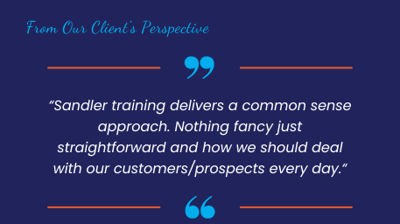Master the Art of Reverse Questioning
Today’s sales environment demands a deeper understanding of customer needs and motivation. Reverse questioning, a technique rooted in the Sandler Selling System, equips salespeople with the tools to navigate this complex environment effectively.
What is Reverse Questioning?
Reverse questioning involves responding to a prospect's question with a question of your own. This technique aims to uncover the underlying intent behind their inquiries. Instead of immediately providing a direct answer, you engage the prospect in a more profound dialogue.
Consider this scenario: a potential customer asks about your product's delivery time. Rather than stating the standard timeframe, ask a reverse question to understand their true needs.
For example: "Delivery timelines are definitely important. Can you help me understand what factors are driving your timeline needs?"
By posing a question in return, you shift the conversation from a transactional exchange to a collaborative exploration of their challenges and priorities.
Or try something like these:
- Good question. Why do you ask?
- I’m glad you asked. Why is that important?
- We get that a lot. What are you hoping I’ll tell you?
- Interesting question. Why did you bring that up just now?
- I appreciate that question. What are you really asking?
The Power of Reverse Questioning
Buyers are more informed and discerning than ever before. They expect personalized interactions that address their specific pain points. Reverse questioning empowers you to:
- Uncover Hidden Pain Points: Go beyond surface-level questions and understand the underlying challenges and motivations driving the prospect's buying decision.
- Position Yourself as an Advisor: Demonstrate genuine interest in the prospect's needs, establishing yourself as a trusted advisor rather than a pushy salesperson.
- Tailor Your Approach: Gather valuable insights to personalize your pitch, addressing their specific concerns and highlighting the solutions your product or service offers.
Avoiding the Reverse Questioning Pitfall
While reverse questioning is a powerful tool, it's crucial to avoid overuse. Bombarding prospects with a barrage of questions can create a sense of interrogation, making them feel uncomfortable. The key is to strike a balance.
- Provide Value in Your Responses: After reversing a question, offer a thoughtful answer that demonstrates your expertise and willingness to help.
- Share Relevant Information: Build rapport by sharing insights and information that shows your understanding of their industry and challenges [6].
- Maintain a Conversational Flow: Use a mix of open-ended and closed-ended questions to create a natural and engaging dialogue.
By mastering the art of reverse questioning, you can elevate your sales interactions, gain deeper insights into your prospects' needs, and ultimately drive better results in a competitive landscape.
Learn more about the power of questions in this complimentary resource: 100 Great Sandler Questions… And When to Ask Them






